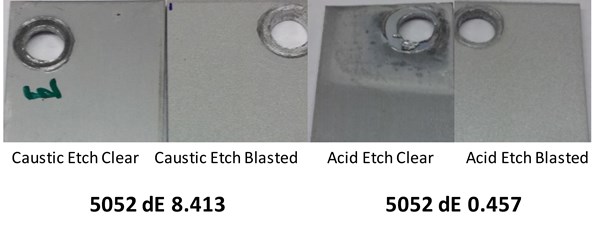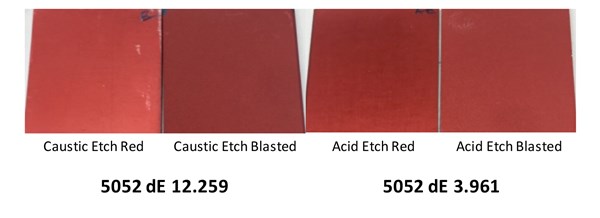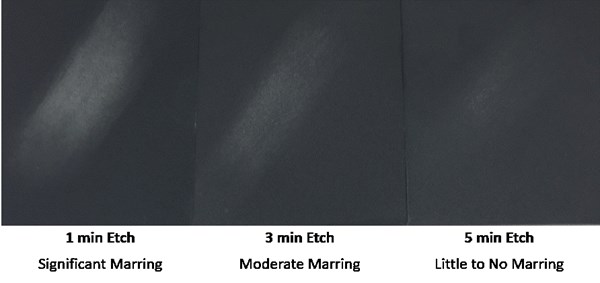The Effect of Pretreatment on Appearance of Anodic Coating
The pretreatment processes prior to anodizing are critical in not only cleaning the aluminum, says Techevon’s Tej Patel, but in also creating a variety of colors and finishes.
Q: What are some considerations when determining the various pretreatment options to use in anodic coatings?
A: The pretreatment processes prior to anodizing are critical in not only cleaning the aluminum, but also creating a variety of colors and finishes. Many of these pretreatment processes effect color dramatically and can also impact coating properties such as coating weight.
The pretreatment process serves both functional and cosmetic use. Functionally, the pretreatment serves to remove machining oils, shop handling stains, extrusion die lines and natural oxides, as well as clean surface for consistent anodizing. Cosmetically, the pretreatment process is used to create a variety of finishes, which include satin matte, bright and mechanically blasted.
As an anodizer, there are three primary pretreatment categories:
Featured Content
- Alkaline etch (caustic etch).
- Acid etch (fluoride based, nonfluoride based, bright dip, electropolish).
- Mechanical finishing (sand blasting, media blasting, grinding/polishing).
These pretreatment categories each provide a unique finish that can affect downstream appearance. Our lab performed a study to test the following variables to understand the effects of varying pretreatment on final color/appearance. These variables included dye coating saturation, likelihood of marring/blemishing and coating weight variation.
In our first set of testing, we analyzed three different 5052 panels in both acid and alkaline etch baths. These panels were processed using no dye (clear), nonsaturated gray dye and completely saturated red dye, in order to understand how a coating saturated with any dye would be affected by the two different types of etchants. Further, these panels were mechanically finished using a time-saver (grinding) and sand-blasting finish in order to determine how mechanical finishing coupled with acid/alkaline etching affected color. In order to determine variation, we calculated a delta E (dE) value which is a metric that assesses color and brightness variation. Table 1 is a summary of the observations.
Table 1
| Panel Type | Acid Etch Treatment | Caustic Treatment |
|
Clear Anodized (No Dye in coating) |
|
|
|
Gray Dye (Nonsaturated Coating) |
|
|
|
Red Dye (Saturated Coating) |
|
|



Based on this information, we were able to conclude that if a caustic etch is selected as a chemical treatment, care must be taken to establish the amount of caustic etching that must be done and the etch rate must be consistent in order to avoid variations in finish brightness. In all the panels we tested, caustic etching produced the most variation in color, particularly in coatings that were not dyed to saturation. The same phenomenon was seen in parts that were sand blasted; therefore, parts that were not sand blasted displayed less variability in color.
To further understand the reason for the appearance difference of the blasted finish and the nonblasted parts, we analyzed the coating weights of each panel to understand if the coating characteristics were different. See the results in Table 2.
Table 2
|
Etch Duration |
Media Blasting |
Coating Weight (mg/in2) |
|
1 Min |
Sand Blasted |
14.141 |
|
3 Min |
Sand Blasted |
15.516 |
|
5 Min |
Sand Blasted |
15.741 |
|
5 Min |
No Blasting |
28.801 |
Based on this data, we can conclude that the media blasting increases the surface area of the part and results in a reduction in coating weight. The process of etching reduces the roughness (thus reducing the surface area) and the coating weights get better, but in no case is the coating weight close to that of a nonmedia-blasted panel. Further, parts that had a longer etch after sand blasting displayed less marring, as seen in the images.

Therefore, increasing the current density could be a good option to improve coating weights of media-blasted parts. Additionally, a slightly longer etch will help reduce the likelihood of marring.
There are several factors to consider when trying to determine what causes variation and inconsistency in the anodizing finish. These include pretreatment variability, alloy type, dye type and anodizing conditions. However, based on our study, the most common reasons for an inconsistent finish are primarily found in the pretreatment steps. Thus, the following areas must be considered:
- Mechanical Pretreatment — if the media blasting is not uniform, the part can show a wavy pattern; and if the media has broken down and not replenished at the appropriate time, the finish will have a different appearance.
- Chemical Pretreatment — too short of an etch will leave the end product less deep in color and will mar very easily; too long of an etch will make the part more reflective (for media-blasted parts) and might bring out the grain in the material; inconsistent etch rate (aggressive versus moderate).
The pretreatment selection is a critical process step before anodizing, and must be fully understood to avoid inconsistent finishes. There are a number of aspects to consider when determining the various pretreatment options:
- Is there a desired cosmetic requirement (for example, matte versus bright, clear versus dyed)?
- What is the condition of inbound parts (for example, oily, extrusion defects, varied mechanical treatment)?
Certain techniques can be used to mitigate issues with pretreatment:
- Increasing etch time on blasted parts reduces the likelihood of marring, making a more aesthetically pleasing part and reduces the roughness of blasted parts, resulting in improvements to coating weight.
- Dyeing to saturation can reduce variability in pretreatment finish. Lighter colors that are not dyed to saturation are susceptible to variation.
- Since media-blasted parts have more surface area than nonblasted parts, one can increase current density to achieve coating weights comparable to nonblasted parts.
If the pretreatment process is well established and repeatable and components become inconsistent, then factors such as the choice of dye, effect of contaminants, apparent and effective dye concentration and sealing method must be considered.
Tej Patel is a director of Techevon. Visit techevon.com.
RELATED CONTENT
-
Anodizing for Bonding Applications in Aerospace
Anodizing for pre-prep bonding bridges the gap between metallic and composite worlds, as it provides a superior surface in many applications on aluminum components for bonding to these composites.
-
Understanding Corrosion and Salt Spray
How it’s produced, NSS testing and how to get the best results possible.
-
Deoxidizing Aluminum as a Pretreatment
This important first step can help prepare the metal for subsequent surface finishing.


















